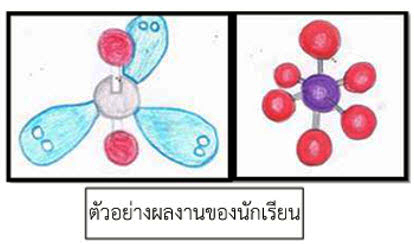การศึกษาความก้าวหน้าทางการเรียนและมโนมติเรื่อง รูปร่างและสภาพขั้วของโมเลกุลโคเวเลนต์ ด้วยเทคโนโลยีออกเมนเต็ดเรียลลิตี้
Main Article Content
Abstract
Study on Normalized Learning Gains and Concepts of Molecular Shape and Polar Covalent Bond Learning through Augmented Reality Technology
Chaiya Promso, Pranorm Saejueng and Karntarat Wuttisela
รับบทความ: 4 เมษายน 2558; ยอมรับตีพิมพ์: 3 มิถุนายน 2558
บทคัดย่อ
งานวิจัยนี้มีวัตถุประสงค์เพื่อศึกษาความก้าวหน้าทางการเรียนของนักเรียนและมโนมติเรื่องรูปร่างและขั้วโมเลกุลโคเวเลนต์ของนักเรียนที่เรียนด้วยการจัดกิจกรรมการเรียนรู้โดยใช้เทคโนโลยีออกเมนเต็ดเรียลลิตี้ (เออาร์) ความก้าวหน้าทางการเรียนประเมินทั้งแบบทั้งชั้นเรียนและรายบุคคล มโนมติวิทยาศาสตร์รวมถึงมโนมติที่คลาดเคลื่อนได้รับการประเมินทั้งระหว่างเรียนและหลังเรียน กลุ่มที่ศึกษาสำหรับงานวิจัยนี้เป็นนักเรียนชั้นมัธยมศึกษาปีที่ 4 จำนวน 33 คน เครื่องมือที่ใช้ในงานวิจัย ได้แก่ แผนการจัดการเรียนรู้ แบบทดสอบวัดผลสัมฤทธิ์ทางการเรียน ใบกิจกรรม และแบบสัมภาษณ์แบบไม่มีโครงสร้าง เก็บรวบรวมข้อมูลและวิเคราะห์โดยใช้สถิติพรรณนา ได้แก่ ค่าเฉลี่ย ร้อยละ ส่วนเบี่ยงเบนมาตรฐาน และความก้าวหน้าทางการเรียน ความก้าวหน้าทางการเรียนหาได้จากสัดส่วนระหว่างผลการเรียนรู้ที่เพิ่มขึ้นจริง (ร้อยละคะแนนสอบหลังเรียน – ร้อยละคะแนนสอบก่อนเรียน) และผลการเรียนรู้สูงสุดที่มีโอกาสเพิ่มขึ้นได้ (100 – ร้อยละคะแนนสอบก่อนเรียน) ผลการวิจัยพบว่า ความ ก้าวหน้าทางการเรียนของนักเรียนแบบทั้งชั้นอยู่ในระดับปานกลาง ค่า <g> เท่ากับ 0.64 จำนวนนักเรียนที่มีความก้าวหน้าทางการเรียนอยู่ในระดับปานกลางขึ้นไปถึงระดับสูงมีค่าเท่ากับร้อยละ 90.9 ระหว่างเรียนนักเรียนเขียนรูปร่างโมเลกุลจากเออาร์ได้ถูกต้อง อย่างไรก็ตาม นักเรียนมีมโนมติคลาดเคลื่อนในโครงสร้าง 3 มิติของ AX5 AX4 และ AX6 คิดเป็นร้อยละ 50 ร้อยละ 12.5 และร้อยละ 12.5 ตามลำดับ ภายหลังเรียนรู้ นักเรียนมีมโนมติวิทยาศาสตร์เรื่องรูปร่างโมเลกุลและสภาพขั้วโมเลกุล แต่ยังมีมโนมติที่คลาดเคลื่อนเรื่องสภาพขั้วพันธะ จากผลการศึกษาแสดงให้เห็นว่า การใช้เออาร์ทำให้นักเรียนมีความก้าวหน้าทางการเรียนเพิ่มสูงขึ้นและยังช่วยให้นักเรียนใช้สมาร์ทโฟนในทางสร้างสรรค์และในทางด้านการศึกษา
คำสำคัญ: เทคโนโลยีออกเมนเต็ดเรียลลิตี้ มโนมติวิทยาศาสตร์ มโนมติที่คลาดเคลื่อน ความก้าวหน้าทางการเรียน
Abstract
The objectives of this research were to investigate normalized learning gains and concepts of Molecular Shape and Polar Covalent Bond of students who have learnt though augmented reality (AR) technology. The normalized gains were assessed both as a whole class and individual students. Students’ science concepts including alternative concepts were evaluated both during and culminating course. Research participants were 33 students of 10th grade. Research instruments consisted of lesson plans, achievement tests, activity sheets, and unstructured interview. Data were collected and then analyzed by means, percentage, standard deviation, and normalized gain (<g>). The <g> is defined as the ratio of the actual average gain (%<post> – %<pre>) to the maximum possible average gain (100 – %<pre>). The results revealed that the class normalized gain was at the medium level with <g> = 0.64. The students’ achieved normalized gain was in ranges of high and medium levels (approximately 90.9%). During class, students were able to draw the molecular structure following AR correctly. However, students had alternative concepts on the 3D structures of AX5, AX4 and AX6 molecules at 50, 12.5, and 12.5%, respectively. At the end of course, students greatly had science concepts on the shape of molecule and molecular polarity, whereas they still had alternative concepts on bond polarity. In summary, the use of AR technology could help improve the students’ learning gain. Moreover, it could help students to use smartphones in creative and educational ways.
Keywords: Augmented reality, Scientific conception, Misconception, Normalized gains
Downloads
Article Details

This work is licensed under a Creative Commons Attribution-NonCommercial 4.0 International License.
References
กานต์ตะรัตน์ วุฒิเสลา. (2554). เกมบัตรสำหรับการจัดการเรียนรู้เรื่องธาตุและสารประกอบ. วารสารหน่วยวิจัย วิทยาศาสตร์เทคโนโลยี และสิ่งแวดล้อมเพื่อการเรียนรู้ 2(2): 132–137.
กานต์ตะรัตน์ วุฒิเสลา. (2557). แบบจำลองอะตอมโมเลกุลทางเลือกสำหรับการสอนเรื่อง ทฤษฎีแรงผลักระหว่างคู่อิเล็กตรอนในวงเวเลนซ์. วารสารหน่วยวิจัยวิทยาศาสตร์ เทคโนโลยี และสิ่งแวดล้อมเพื่อการเรียนรู้ 5(2): 209–213.
จำรัส กลิ่นหนู. (2556). การประยุกต์ใช้เทคโนโลยีความจริงเสริมสร้างบทเรียนอิเล็กทรอนิกส์และกิจกรรมการเรียนรู้เรื่องความปลอดภัยของสารสนเทศเพื่อเพิ่มผล สัมฤทธิ์ทางการเรียนวิชาเทคโนโลยีสารสนเทศ. สืบค้นเมื่อวันที่ 21 กุมภาพันธ์ 2558, เข้าถึงได้จาก http://oer.thaicyberu.go.th/handle/6626105234/847
ณัชธฤต เกื้อทาน ชาตรี ฝ่ายคำตา และสุดจิต สงวนเรื่อง. (2554). แบบจำลองความคิดเรื่องพันธะเคมีของนักเรียนชั้นมัธยมศึกษาปีที่ 4. วารสารสงขลานครินทร์ ฉบับสังคมศาสตร์และมนุษยศาสตร์ 17(2): 299–314.
ณัฏฐ์ ดิษเจริญ กรวัฒน์ พลเยี่ยม พนิดา วังคะฮาต และปุริม จารุจำรัส. (2557). การพัฒนาสื่อการเรียนรู้เรื่อง โครงสร้างอะตอมและพันธะเคมีด้วยเทคโนโลยีออกเมนเต็ดเรียลลิตี้. วารสารหน่วยวิจัยวิทยาศาสตร์ เทคโนโลยี และสิ่งแวดล้อมเพื่อการเรียนรู้ 5(1): 21–27.
ดวงกมล บำรุงบ้านทุ่ม และสุธา ภู่สิทธิศักดิ์. (2556). ตัวแทนความคิดเรื่อง พันธะเคมี ของนักเรียนชั้นมัธยมศึกษาปีที่ 4 ที่เรียนจากการจัดกิจกรรมการเรียนรู้ แบบเปรียบเทียบ (Analogy) ตามแนว FAR Guide. วารสารศึกษาศาสตร์ มหาวิทยาลัยขอนแก่น 7(4): 127–136.
พนิดา ตันศริ. (2553). โลกเสมือนผสานโลกความจริง (Augmented Reality). วารสารสำนักบริหารมหาวิทยาลัยกรุงเทพ 30(2): 169–175.
ศศินี อังกานนท์. (2557). การใช้ดินสอมาสร้างโมเดล 3 มิติแสดงรูปร่างโมเลกุลโคเว-เลนต์ที่สอดคล้องกับทฤษฎี VSEPR ศูนย์ บริการออนไลน์ด้านการจัดการเรียนการสอนวิชาเคมีด้วยวิธีสืบเสาะหาความรู้. เข้าถึงได้จาก http://www.mwit.ac.th/~chem/ Inquiry/index.html, สืบค้นเมื่อวันที่ 22 กุมภาพันธ์ 2558.
สถาบันส่งเสริมการสอนวิทยาศาสตร์และเทคโนโลยี (สสวท). (2556). เคมี เล่ม 1. พิมพ์ครั้งที่ 5. กรุงเทพฯ. โรงพิมพ์ สกสค.
สมเจตน์ อุระศิลป์ และศักดิ์ศรี สุภาษร. (2554). การเปรียบเทียบมโนมติก่อนและหลังเรียน เรื่องพันธะเคมี ตามโมเดลการเรียนรู้ T5 แบบกระดาษ. วารสารวิจัย มข 1(1): 38–57.
สมศักดิ์ เตชะโกสิท และณมน จีรังสุวรรณ. (2556). แนวทางในการจัดการเรียนรู้ในห้องปฏิบัติการวิทยาศาสตร์โดยใช้เทคโนโลยีเสมือนจริง. วารสารหน่วยวิจัยวิทยาศาสตร์เทคโนโลยี และสิ่งแวดล้อมเพื่อการเรียนรู้ 4(2): 117–123.
Birk, J. P., and Kurtz, M. J. (1999). Effect of experience on retention and elimination of misconceptions about molecular structure and bonding. Journal of Chemical Education 76: 124–128.
Coll, R. K., and Treagust, D. F. (2001). Learners’ mental models of chemical bonding. Research in Science Education 31: 357–382.
Coll, R. K., and Treagust, D. F. (2002). Exploring tertiary students’ understanding of covalent bonding. Research in Science and Technological Education 20: 241–267.
Hake, R. R. (1998). Interactive-engagement vs traditional methods: A six-thousand student survey of mechanics test data for introductory physics courses. American Journal of Physics 61(1): 64–74.
Johnstone, A.H. (1993). The development of chemistry teaching: A changing response to a changing demand. Journal of Chemical Education 70(9): 701-705.
Özmen, H. (2004). Some student misconcep-tions in chemistry: A literature review of chemical bonding. Journal of Science Education and Technology 13(2): 147–159.
Peterson, R. F., and Treagust, D.F. (1989). Grade–12 students' misconceptions of covalent bonding and structure. Journal of Chemical Education 66(6): 459.
Peterson, R. F., Treagust, D. F., and Garnett, P. (1989). Development and application of covalent bonding and structure following a course of instruction. Journal of of a diagnostic instrument to evaluate grade–11 and –12 students' concepts. Research in Science Teaching 26(4): 301–314.
Selco, J., Bruno, M., and Chan, S. (2013). Hands on, Minds on Periodic Table: Visualizing the Unseen. Retrieved from http://www.researchgate.net/publication/ 260671680_Discovering_Periodicity_Hands-On_Minds-On_Organization_of_the_Periodic_Table_by_Visualizing_the_Unseen, Febuary 24, 2015.
Taber, K. S., Coll, R. K., and Gilbert, J. K. (2002). Chemical Education: towards Research–based Practice. Netherlands: Kluwer Academic.
